Special Historical Issue
Reprinted from "Crown Jewels of the Wire", July 2003, page 21
Editor's note: Summer of 1865 brought to America a sense of uncertainty mixed
with unlimited expectations. The Civil War had just ended, but tensions ran high
as restoration of a torn nation began. The investigation into the assassination
of President Lincoln continued, and the world wondered if the government that
won the war could survive the loss of its leader. But as the summer progressed,
a technological miracle loomed on the horizon. Newspapers proclaimed the world
would soon be connected by telegraph lines that would span the continents.
Europe and America would be linked by the Trans-Atlantic Cable; Asia and Western
America would be connected by a line known as the Collins Overland Line; and
work was nearing completion on a land and sea line connecting Europe to India.
Harper's Weekly newspaper chronicled the progress of the three lines, treating
them as partners in some grand scheme rather than the competitors they actually
were. The newspaper described the events unfolding before its readers as the
greatest human achievement over nature.
In this special historical issue of
Crown Jewels we present both the illustrations and the text from the August 12,
1865 issue of Harper's Weekly, and excerpts from a book written about the
Collins Line. (Place names are spelled as they were in 1865, rather than as we'd
spell them today.)

The Collins Overland Telegraph
"This immense enterprise, which is to connect America with Europe by the
way of California, Behring Strait, and the Amoor River is being pushed forward
with the utmost energy during the present season, under the auspices of the
Western Union Telegraph Company. The wires of the California Telegraph Company
have during the past winter been extended through Oregon and Washington
Territory, as far as New Westminster, the capital of British Columbia, and are
now in operation to that point. At New Westminster the Collins Overland
Telegraph proper commences, and will extend up Frazer River nearly to its
source, and thence nearly parallel with the coast, following the general
direction of the valley between the Rocky Mountains and the Coast Range to a
point at or near Behring Strait, which will be cross by a submarine cable. The
line will thence extend through the eastern portion of Siberia until it meets
the telegraph, now nearly completed by the Russian Government, from St
Petersburg to the Amoor River.
"The whole work is under the general supervision of Colonel Charles S.
Bulkley, Engineer-in-Chief, who will be remembered as the late efficient
superintendent of the United States military lines in the Department of the
Gulf. Colonel B. is a man of great experience in practical telegraphing, having
constructed the first range of wires between Washington and New Orleans, in the
year 1847.
"The construction of the overland line through the colony of
British Columbia is proceeding with great rapidity, considering the mountainous
and difficult nature of the country. This division is under the immediate charge
of Assistant-Engineer Ed. Conway, late of the United States Military Telegraph.
"A party, under command of Major F.L. Pope, of Massachusetts, is now
engaged in making explorations in the county lying between the head of Frazer
River and Behring Strait, in order to determine the most practicable route for
the telegraph. Other exploring parties will also be set at work the present
season along the Asiatic portion of the route. The city of New Westminster, of
which we give an illustration, is pleasantly situated on the north bank of the
Frazer, about fifteen miles from its mouth. This sport was selected as the
capital of the colony in 1859. At that time a dense forest covered the present
site of the city. The trees in this portion of British Columbia grow to an
astonishing size. Many of the stumps still remaining in the city measure from 15
to 20 feet in diameter. The trees themselves average over 200 feet in height,
and one was recently cut at New Westminster and attained the enormous height of
309 feet!
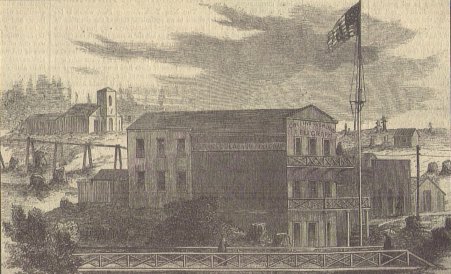
New Westminster has already become a place of some size and
importance, and contains, besides many stores and dwellings, four churches, a
bank, the colonial hospital and the government buildings. The residence of the Governor is delightfully situated near the
river, a mile above the town.
"As a port New Westminster is possessed of
great advantages, the Frazer being navigable for vessels drawing 18 or 20 feet
of water as far as this place. The overland telegraph crosses the river in front
of the city by means of a submarine cable 2500 feet in length.
"Our other
illustration gives a view of the office and Headquarters of the Telegraph
Company at New Westminster. The work of construction was normally commenced by
setting the first pole, which is seen near the right of the engraving, on the
24th of February, 1865."
Girdling the World by Telegraph
"It is now quite certain, in the event of the success of the Atlantic
Telegraph, that within the next five years there will be a continuous chain of
telegraphic communication around the globe. The telegraph map of the world will
give our readers at a glance the whole of this grand system of
intercommunication. The three separate divisions may be thus designated:
- The
Atlantic Telegraph, from Valentia to Heart's Content, connecting Europe with
America.
- The Overland Telegraph, connecting America with Asia.
- The
Indo-European Telegraph, connecting Asia with Europe.
"The most important
of these three sections, and at the same time the most uncertain, is the
Atlantic Telegraph. The cable, which was completed on the 29th of May, has a
continuous and uninterrupted circuit of 2300 miles. Every possible precaution
has been regarded in its construction and in paying it out. As the former cable,
though not nearly so carefully wrought, was momentarily a success, it seemed to
demonstrate the possibility of a telegraphic communication across the Atlantic.
The present cable will bear a strain upon it of seven and three-fourth tons. If
successful -- and its patrons surely deserve success for their perseverance --
it will
be the greatest triumph ever achieved by mechanical art of nature. Its success
will be something more thrilling than the denouement of the most exciting
romance, more poetic than Shakespeare's happiest thought.
"The Overland
Telegraph is peculiarly important to this country and to Russia, and, in case of
any failure or interruption in the great Atlantic cable, will afford
communication between Europe and this country across Asia.
"Great Britain
has granted a charter for the construction of the line through her American
possessions, and last July Congress, in chartering the company, directed the
Secretary of the Navy to detail, for the use of the surveys and soundings along the portion of the Pacific
coast, both of America and Asia, where it is proposed to establish said
telegraph, one steam or sailing vessel, in his discretion, to assist in surveys
and soundings, laying down submerged cable, and in transporting materials
connected therewith. Secretary Welle's" discretion" has already
assigned the steam revenue cutter, transferred from the Treasury to the Navy
Department, which as been refitted and armed at San Francisco, to the service of
the expedition. Another and larger steamer was also sent out from this side.
With the vessels already employed, and those that will be engaged in the
constant transportation of materials and supplies, the land and naval force of
the expedition will number not less than two thousand men.
"New
Westminster, the Gulf of Georgia, British Columbia, is the immediate base of
operations. The first stretch will be from New Westminster to Fort Alexander
thence to Fort Frazer or Fort St. James, and thence to Fort Bahine, a
distance, as the crow flies, of about four hundred miles. The country thus far
as been explored and is settled "in spots" by fur-hunters and traders.
Far beyond, on a nearly direct line to the Petty River, are forts and stations,
here and there, belonging to or built for the Hudson's Bay Company, but the
necessity for supplies and materials will keep the exploring party, and will
establish the telegraph line, nearer the coast, and the route proposed
contemplates an exploration of 3000 miles through wild and heretofore almost
untrodden territory from Lake Bahine, the centre of British Columbia, to the
Yukan River, the extreme limit of the British possessions in America.
"From
Yukan River to Cape Prince of Wales, the nearest point to the Asiatic coast, the
route is easy; and from this cape to Cape East, the distance across Behring
Strait requiring a submerged cable, is only thirty-six miles.
"On the
Asiatic continent the point to be reached is the mouth of the Amoor River. The
route may be extend by land the entire distance, or only to Penjinsk Gulf, and
by cable across the Okhotsk sea. To reach the mouth of the Amoor River will
require a period of at least three years, and by that time the Russians will
have completed the connecting line from this point to Irkoutsk, which is already
connected by telegraph with St. Petersburg. Then, with or without the Atlantic
telegraph line, the Puck prophecy of putting a girdle round the earth will be
fully realized.
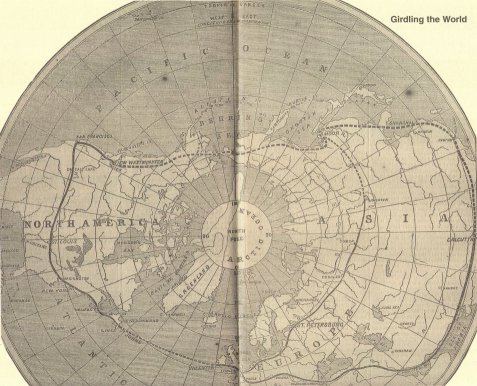
"With the mouth of the Amoor River there are in reality two
systems of telegraphic communication with Europe -- The Indo-European and the line
passing through Siberia to St Petersburg. The Indo-European telegraph extends
from England to India through Turkey and the Persian Gulf, partly by land and partly by sea.
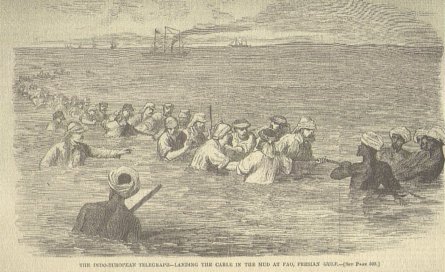
"The
route through the Persian Gulf was established after failure to establish
communication by way of the Red Sea. The line was laid under the direction of
Colonel Patrick Stewart, aided by Sir Charles Bright and Mr. Latimer Clarke. The
great difficulty in this work was the manufacture and laying of the enormous
mass of cable, nearly 1500 miles, and weighing upward of 5000 tons. On the 3rd
of February 1864 the laying of the first section of the cable between Gwadur and
Mussendom, a barren promontory at the entrance of the Persian Gulf on the
Arabian side, was commenced and was completed in the course of a month. One the
25th of March the section between Mussendom and Bushire was completed. The last
section -- between Kurrachee and the head of the Persian Gulf at Fao -- was completed
April 5. We give a sketch of the laying of the shore end in the mud at Fao,
which is a small Turkish village at the confluence of the Tigris and Euphrates.
At this point the extreme shallowness of the water for several miles made it
necessary to land the cable in boats of a combination of mud and water, which
rendered the operation both difficult and dangerous. The communication by way of
the Persian Gulf, was recently interrupted, has been restored."
Editor's Note: As you just read, the line to India ran both underwater and
over land. This was before threaded insulators had been invented. Makes me
wonder what styles of insulators might have been placed into service. Since the
line passed through modern day Iraq, I also wonder if any of our servicemen
over there presently will find any.
The Trans-Atlantic Cable was successfully completed on July 27, 1866. Work on
the Collins Overland Lane ceased almost immediately. Well, in British Columbia
where telegraph communications brought word of the Cable's success, work ceased
right away as construction of the immense overland line was immediately
impractical and too expensive. However, work continued in Siberia for almost
another full year as crews were cut off from the news.
Construction of the
Siberian section of the line is chronicled in the book, "Tent Life in
Siberia" by George Kennan, a member of the crew. The following excerpts
give some insight into what must have been one of the loneliest construction
projects ever undertaken. We pick up the story in Siberia in 1866.
"The brief excitement produced by the arrival of the Varag and the Clara
Bell was succeeded by another long, dreary month of waiting, during which we
lived as before in lonely discomfort at the mouth of the Geezhega River. Week
after week passed away without bringing any tidings from the missing ships, and
at last the brief northern summer closed, snow appeared upon the mountains, and heavy long-continued storms announced the speedy approach of winter. More
than three months had now elapsed since the supposed departure of the Onward and
the Palmetto from San Francisco, and we could only account for their
non-appearance by supposition that they had either been disabled or lost as sea.
On the 18th of September Major Abasa determined to send a messenger to the
Siberian capital, to telegraph the Company for instructions. Left as we were at
the beginning of a second winter without men, tools, or materials of any kind,
except 50,000 insulators and brackets, we could do nothing toward the
construction of the line, and our only resource was to make our unpleasant
situation known to the Company. On the 19th, however, before this resolution
could be carried into effect, the long-expected barque Palmetto arrived, followed
closely by the Russian supply steamer Saghalin.
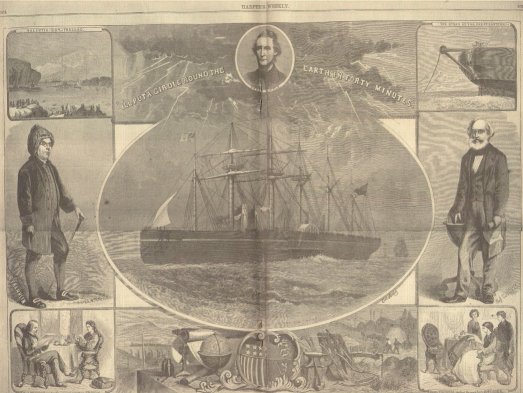
"The prospects of the
enterprise at the opening of the second winter were more favorable than they had
been at any time since its inception. The Company's vessels, it is true, had
been very late in their arrival, and one of them, the Onward, had not come at
all; but the Palmetto had brought twelve or fourteen more men and a full supply
of tools and provisions. Major Abasa had gone to Yakoutsk to hire six or eight
hundred native laborers and purchase three hundred horses, and we hoped that the
first of February would find the work progressing rapidly along the whole extent
of the line.
"As soon as possible after the departure of the Palmetto, I
sent Lieut. Sandford and the twelve men whom she had brought into the woods on the
Geezhega River above the settlement, supplied them with axes, snow shoes, dog
sledges, and provisions, and set them a work cutting poles and building houses,
to be distributed across the steppes between Geezhega and Penzhinsk Gulf. I also
sent a small party of natives under Mr. Wheeler to Gamsk, with five or six
sledge-loads of axes and provisions for Lieut. Arnold, and despatches to be
forwarded to Major Abasa. For the present nothing more could be done on the
coast of the Okhotsk Sea, and I prepared to start once more for the North. We
had heard nothing whatever from Lieut. Bush and party since the first of the
previous May, and we were of course anxious to know what success he had met with
in cutting and rafting poles down the Anadyr River, and what were his prospects
and plans for the winter.
"The late arrival of the Palmetto at Geezhega had
led us to fear that the vessel destined for the Anadyr might also have been
detained, and have placed Lieut. Bush and party in a very unpleasant if not
dangerous situation. Major Abasa had directed me therefore, when he sailed for
Okhotsk, to go by the first winter road to Anadyrsk and ascertain whether the
Company's vessels had been at the mouth of the river, and whether Bush needed
any assistance. As there was no longer anything to detain me at Geezhega, I
packed up my camp equipage and extra fur clothes, loaded five sledges with tea, sugar, tobacco,
and provisions, and on November 2nd started with six Cossacks for my last
journey to the Arctic Circle.
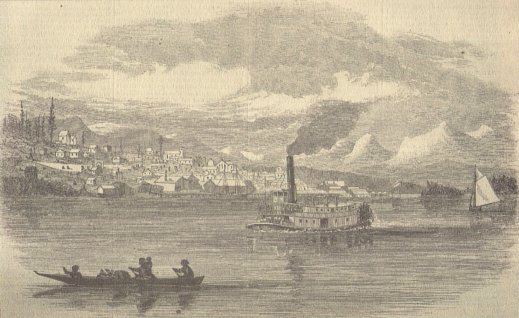
New Westminster, British Columbia - 1865
"In all my Siberian experience I can recall
no expedition which was so lonely and dismal as this. For the sake of saving
transportation, I had decided not to take any of my American comrades with me;
but by many a silent campfire did I regret my self-denying economy, and long for
the hearty laugh and good humored raillery of my friends. During twenty-five
days I did not meet a civilized being or speak a word of my native language, and
at the end of that time I would have been glad to talk to an intelligent
American dog.
"Our progress toward Anadyrsk after we left the coast of the
Okhotsk Sea was very slow, on account both of the shortness of the days, and the
depth and softness of the freshly fallen snow. Frequently, for ten or fifteen
miles at a stretch, we were compelled to break a road on snowshoes for our
heavily loaded sledges, and even then our tired dogs could hardly struggle with
the soft powdery drifts. The weather, too, was so intensely cold that my
mercurial thermometer, which indicated only minus-23-degrees, was almost
useless. For several days the mercury never rose out of the bulb, and I could
only estimate the temperature by the rapidity with which my supper froze after
being taken from the fire. More than once soup turned from a liquid to a solid
in my hands, and corn froze to my tin plate before I could finish eating it.
"I had confidently expected when I left Geezhega that I would meet somewhere on the road a courier with news and despatches from Bush, and I was
very much disappointed and a little alarmed when I reached Penzhina to find that
no one had arrived at that place from Anadyrsk, and that nothing had been heard
from our party since the previous spring. I felt a presentiment that something
was wrong, because Bush had been expressly directed to send a courier to
Geezhega by the first winter road, and it was now late in November.
"On the
following day my worst anticipations were realized. Late in the evening, as I
was sitting in the house of a Russian peasant drinking tea, the cry was raised
that "Anadyrski yaydoot"... some one was coming from Anadyrsk; and
running hastily out of the house I met a long haired Anadrysk priest just as he
stepped from his sledge in front of the door. My first question of course was,
"Where's Bush?" But my heart sank as the priest replied, "Bokh
yevo zniet"...God only knows. "But when did you last see him--where
did he spend the summer?" I inquired. "I saw him last at the mouth of
the Anadyr River, in July" said the priest, "and since that time
nothing has been heard from him". Availing ourselves of the road which had
been broken by the sledges of the priest, we made more rapid progress toward Anadyrsk than I had
anticipated.

TENT LIFE IN SIBERIA
Kennan met Bush just before getting to Anadyrsk and heard this
tale. "They had gone down to the mouth of the Anadyr in the early part of
June, and had waited there for the Company's vessels almost four months. Their
provisions had finally given out, and they had been compelled to subsist
themselves upon the few fish which they were able to catch from day to day, and
to go hungry when they could catch none. For salt they scraped the staves of an
old pork barrel which had been left at camp from the previous winter, and for
coffee they drank burned rice water. At last, however, salt and rice both
failed, and they were reduced to an unvarying and often scanty diet of boiled
fish, without coffee, bread or salt. Living in the midst of a great moss swamp
fifty miles from the nearest tree, dressing in skins for the want of anything
else, suffering frequently from hunger, tormented constantly by mosquitoes, from
which they had no protection, and looking day after day and week after week for
vessels which never came, their situation was certainly miserable.
"The
Company's barque Golden Gate had finally arrived in October, bringing
twenty-five men and a small steamer; but winter had already set in, and five
days afterwards, before they could finish discharging the vessel's cargo, she
was wrecked by ice. Her crew and nearly all her stores were saved, but by this
misfortune the number of the party was, increased from twenty-five to
forty-seven, without any corresponding increase in the quantify of provisions
for their subsistence."
Later in the book Kennan described receiving news that the TransAtlantic
Cable had been successfully laid. "Late in May the ice in the Gulf of
Geezhega began to disappear, and on the first of June (1867) we boarded a
whaling vessel off Matooga Island. It was the barque Sea Breeze, from New
Bedford, Mass, with American news to the first of March. The Atlantic cable had
proved to be an entire success, and from the San Francisco Bulletin we learned
that in consequence of this success "all work on the Russian American
Telegraph line had been stopped and the enterprise abandoned."
"On the
15th of July the Company's barque Onward arrived from San Francisco, bringing
orders to close up the business, discharge our native laborers, gather up our
men, and return to America. The Atlantic cable was a complete success, and the
Western Union Telegraph Company, after sinking nearly $3,000,000, had decided to
abandon the project of an overland line to Russia. It seemed hard to give up at
once the object to which we had devoted three years of our lives, and for whose
attainment we had suffered all possible hardships of cold, exile, and starvation; but we had no alternative, and began at once
to make preparations for our final departure.
"The situation of affairs at
the time the work was abandoned was briefly as follows. We had explored and
located the whole route of the line, from the Amoor River to Behring's Straits.
We had prepared altogether about 15,000 telegraph poles, built between forty and
fifty station houses and magazines, cut nearly fifty miles of road through the
forests in the vicinity of Gamsk and Okhotsk, and accomplished a great deal of
preparatory work along the whole extent of the line. Our resources for another
season would have been ample. Besides seventy-five Americans, we had a force of
a hundred and fifty natives already at work between Gamsk and Okhotsk, and six
hundred more were on their way from Yakootsk; our facilities for transportation
another year would have been almost unlimited. We had a small steamer on the
Anadyr River, and had ordered another for the Penzhina; we owned a hundred and
fifty dogs and several hundred reindeer at Gamsk, Okhotsk, and Geezhega, and had
purchased three hundred Siberian horses at Yakootsk, with an immense amount of
material for their equipment and subsistence. By the first of September we would
have been able to take the field with a force of nearly a thousand men. The
success of the Atlantic cable, however, rendered all our preparations
unavailing. We might build the line, but there was no Company in the world which
would undertake to sustain and work it a single year in competition with the
cable.
"In itself, the route of the Russo-American Telegraph Company from
Behring's Straits to the' Amoor River presented no insurmountable obstacles to
the construction of a line. The work would have been difficult, but it could
have been accomplished, and I believe that this was a much more practical route
for a line to China than the one recently proposed by Mr Collins, via the
Aleutian Islands, Kamtchatkan, and Japan. Labor in Siberia is very cheap, and
almost any desired number of men can be engaged at Yakootsk for about forty
dollars a year and subsistence. Horses can be purchased at Yakootsk and Kolyma
to the number of five or six hundred, at prices varying from fifteen to
twenty-five dollars. Nothing need be brought from America except wire,
insulators and tools, and a small quantity of provisions for a limited number of
American foremen. If there were any call for it, I believe that a line could be
successfully built from Behring's Straits to the Amoor River in two years, at an
expense not exceeding $250,000.
"The remainder of the summer of 1867, after
the arrival of the Onward, was almost entirely consumed in picking up our
scattered parties along the coast of the Okhotsk Sea, selling off our stores to Russian merchants, and making preparations for departure. A separate vessel
had been sent to the mouth of the Anadyr after Bush and his comrades, so that we
did not have another opportunity of seeing them. On the 6th of August Major
Abasa left for St. Petersburg, overland, and early in October the Onward sailed
for San Francisco, carrying back all but four of the employees of the
unfortunate Russo-American Telegraph Expedition."
Kennan and three
companions stayed behind for more adventures. "It was a lonely time in that
dreary settlement after all our comrades had gone; but winter soon set in,
and on the 24th of October, we started out on dog sledges for a journey of more
than 5,000 miles to St. Petersburg."
Kennan sailed from San Francisco in July of 1864. He arrived by dog sled in
Moscow in January of 1868, having at last obtained a view of the entire proposed
route of the line across Asia. It's a testament to his fortitude that no matter
how hard times were, Kennan remained confident and optimistic that the
enterprise could have succeeded.
What were those 50,000 insulators introduced to
Siberia by the Americans? When the Collins line was constructed through Oregon
and Washington in 1864, insulators used included glass blocks, wood block
ramshorns, and CD 736's embossed N. Y.& E.RR In British Columbia, the line
was constructed using CD 735 Chester's and Tillotson's. While not possible to
say for sure what had been shipped to Siberia, one account of the selling of
goods to the Russian merchants at the end of the enterprise talks about efforts
to sell the insulators as tea cups. Hmm. Perhaps that wasn't a bad idea,
considering a 735 could hold all the tea you could drink... before it froze.
Bibliography:
Harper's Weekly, newspaper, edition of August 12, 1865.
Tent Life In Siberia, by George Kennan, published by G.P. Putnam's Sons, New York &
London, 1874, 425 pgs.
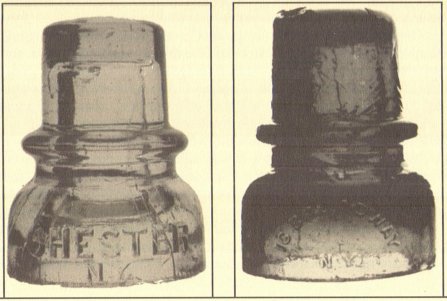
Photographs by Ray Klingensmith.
|
